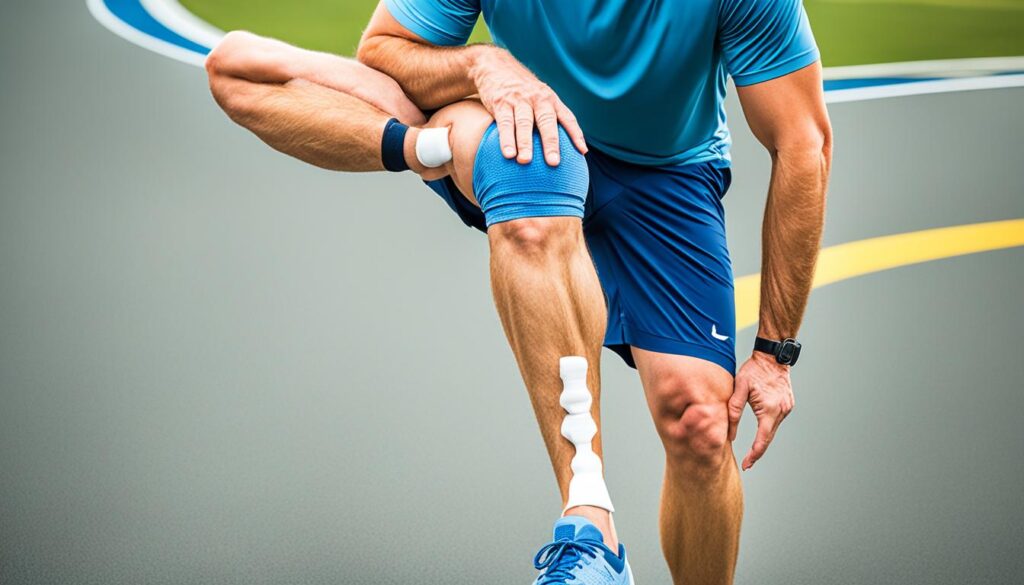Did you know that patellar dislocation accounts for approximately 2 to 3% of knee injuries? This common condition can cause significant pain and functional limitations, particularly among young and active individuals.
Patellar instability is a spectrum of conditions, ranging from intermittent subluxations to dislocation. Acute patellar dislocations often occur due to trauma, while recurrent subluxation and chronic laxity can also contribute to this condition. Patellar dislocation affects a wide range of individuals, but it is particularly prevalent in adolescent females and athletes.
Let’s delve into the causes, symptoms, treatment options, and prevention strategies for patellar dislocation, so we can better manage and prevent this debilitating knee injury.
Patellar Dislocation Causes
Acute patellar dislocations can be caused by various factors, ranging from traumatic injuries to anatomical predispositions. Understanding the causes of patellar dislocation is essential for effective diagnosis and treatment.
Traumatic Injuries
Non-contact twisting injuries and direct blows to the medial aspect of the knee are common causes of acute patellar dislocations. One common mechanism involves external tibial rotation with the foot fixed on the ground. This forceful movement can lead to the displacement of the patella from its normal position.
Anatomical Predispositions
Anatomical variations can increase the risk of patellar dislocation. Patella alta, a condition characterized by a high-riding patella, and trochlear dysplasia, an abnormality in the groove of the thighbone where the patella slides, are examples of such predispositions. These anatomical variations can impair the normal tracking and stability of the patella, increasing the likelihood of dislocation.
Ligamentous Laxity
Ligamentous laxity, also known as joint hypermobility, can contribute to patellar dislocation. Individuals with generalized ligamentous laxity are more prone to joint instability and dislocation. This laxity is often seen in females or those with connective tissue disorders.
Muscular Imbalance
Muscular imbalance, specifically weakness of the vastus medialis oblique (VMO), is another factor that can contribute to patellar instability. The VMO is a muscle responsible for stabilizing the patella during knee movement. When the VMO is weakened or imbalanced with other muscles, it can lead to patellar malalignment and dislocation.
Understanding the causes of patellar dislocation can help healthcare professionals develop targeted treatment plans and preventive measures. By addressing the underlying factors contributing to patellar instability, patients can regain knee stability and reduce the risk of future dislocations.

| Cause | Description |
|---|---|
| Traumatic Injuries | Non-contact twisting injuries or direct blows to the medial aspect of the knee, often involving external tibial rotation with the foot fixed on the ground. |
| Anatomical Predispositions | Anatomical variations such as patella alta and trochlear dysplasia, which can lead to abnormal patellar tracking and stability. |
| Ligamentous Laxity | Generalized ligamentous laxity, commonly observed in females or individuals with connective tissue disorders, can contribute to joint instability and dislocation. |
| Muscular Imbalance | Weakness or imbalance in the vastus medialis oblique (VMO) muscle, responsible for stabilizing the patella, can result in patellar malalignment and dislocation. |
Patellar Dislocation Symptoms
When it comes to patellar dislocation, understanding the symptoms is crucial for early detection and appropriate treatment. Here are the key symptoms to watch out for:
- Audible pop: Many individuals report hearing a distinct popping sound at the time of the dislocation.
- Buckling of the knee: The knee may give way or buckle, causing instability and difficulty in maintaining balance.
- Intense pain: Patellar dislocation typically results in severe pain at the site of the injury.
- Sudden swelling and bruising: The knee may immediately swell and show signs of bruising due to the trauma.
- Locking of the knee: In some cases, the dislocated patella can get stuck in an abnormal position, causing temporary immobility or locking of the knee joint.
- Inability to walk: Individuals may have difficulty walking or putting weight on the affected leg.
- Visual misplacement of the kneecap: The patella may appear visibly dislocated or out of its normal position.
Additional symptoms may include pain, clicking, and catching sensations during movement, with symptoms typically worsening during flexion and kneeling. It is important to note that these symptoms can manifest in both acute and chronic cases of patellar dislocation.
Proper recognition of these symptoms can help individuals seek timely medical attention and receive appropriate treatment to address the dislocation and prevent further damage.

Placing the image above centers it within the content, making it visually appealing and relevant to the topic of patellar dislocation symptoms.
Patellar Dislocation Treatment
Treatment for patellar dislocation depends on the severity and recurrence of the condition. The goal of initial treatment is to reduce the dislocation and address the underlying causes of instability. This may involve a combination of non-surgical and surgical interventions.
Non-Surgical Treatment
Non-surgical treatment options for patellar dislocation include:
- Physical therapy: Strengthening the quadriceps muscles can help improve knee stability and reduce the risk of future dislocations.
- Bracing or taping: These techniques can be used to control the movement of the kneecap and provide additional support.
Non-surgical treatment is usually recommended for patients with mild or first-time dislocations, as well as those who do not have significant pain or functional limitations. It is important to note that non-surgical treatment may not be sufficient for individuals with severe symptoms or repeated dislocations.
Surgical Treatment
Surgery may be necessary for patients with significant pain, recurrent dislocations, or structural abnormalities that contribute to patellar dislocation. Surgical interventions aim to correct the displacement of the patella and restore normal alignment and function.
Common surgical procedures for patellar dislocation include:
- Lateral release: This procedure involves cutting the tight lateral ligaments to allow the patella to return to its normal position.
- Realignment of muscles and kneecap: In some cases, the muscles and kneecap may need to be repositioned to prevent future dislocations.
Surgical treatment is often recommended for patients who have not responded to non-surgical options or who have structural abnormalities that require correction. It is important to consult with a healthcare professional to determine the most appropriate treatment plan based on individual needs and circumstances.
Rehabilitation
Rehabilitation plays a crucial role in the treatment of patellar dislocation. After surgery or as part of non-surgical treatment, a structured rehabilitation program is necessary to restore knee stability, strength, and functionality.
A healthcare professional, such as a physical therapist, will guide patients through a progressive rehabilitation program that may include:
- Range-of-motion exercises to improve knee flexibility.
- Strength-training exercises to target the quadriceps and other muscles that support the knee.
- Proprioception and balance exercises to enhance joint awareness and stability.
- Functional exercises to improve agility, coordination, and sport-specific movements.
Rehabilitation should be tailored to the individual’s specific needs and may vary in duration depending on the severity of the condition and the surgical intervention performed. Compliance with the rehabilitation program is crucial for achieving optimal outcomes.
By combining appropriate treatment options, including both non-surgical and surgical interventions, along with a comprehensive rehabilitation program, individuals with patellar dislocation can regain knee stability, reduce the risk of future dislocations, and restore overall knee functionality.
Patellar Dislocation Surgery
For patients with severe symptoms or recurrent dislocations, patellar dislocation surgery may be considered. This surgical intervention aims to address the underlying causes of patellar instability and restore the kneecap to its normal position.
A common surgical technique used in patellar dislocation surgery is lateral release. This involves cutting the tight lateral ligaments to allow the patella to resume its proper alignment. By releasing these tight ligaments, the kneecap can regain its stability and reduce the risk of future dislocations.
In some cases, arthroscopy may be performed during the surgery. This minimally invasive procedure allows the surgeon to visualize the joint and assess its alignment. Through arthroscopy, the surgeon can accurately diagnose any additional issues contributing to patellar instability and address them accordingly.
Individuals with repeated dislocations may require surgical realignment of the muscles and the kneecap. This procedure helps to provide long-term stability and prevent future instances of patellar dislocation.
Risks and Recovery
As with any surgery, there are risks involved in patellar dislocation surgery, including infection, blood clots, and nerve damage. Recovery from the surgery may vary depending on the individual and the extent of the procedure. Generally, rehabilitation will be necessary to restore strength and flexibility in the knee joint.
In some cases, a period of immobilization and the use of crutches may be required following patellar dislocation surgery. Physical therapy will gradually be introduced to improve range of motion, strengthen the surrounding muscles, and enhance overall knee function.
It is important for patients to follow the post-surgical guidelines provided by their healthcare team to ensure a successful recovery and minimize the risk of complications.
Patellar Dislocation Rehabilitation
Rehabilitation plays a crucial role in the effective treatment of patellar dislocation, aiming to restore knee stability and function. Physical therapy is a key component of the rehabilitation process, focused on strengthening the quadriceps and improving overall knee strength and flexibility. By targeting these specific areas, we can enhance patellar tracking and reduce the risk of future dislocations.
During the rehabilitation period, healthcare professionals may utilize bracing and taping techniques to provide additional support to the kneecap. These assistive measures can help protect the joint and enhance the healing process. Additionally, bracing and taping can aid in the prevention of further dislocations, offering stability and promoting proper alignment.
The rehabilitation process follows a gradual progression, guided by the healthcare professional, to ensure a safe and effective recovery. This approach involves a well-structured series of exercises and activities tailored to the individual’s needs and abilities. The exercises will focus on improving strength, flexibility, and proprioception, helping patients regain optimal knee function.
Throughout the rehabilitation journey, patients will learn proper body mechanics and movement patterns to prevent future injuries. Education on proper landing techniques, jumping mechanics, and joint protection strategies will be provided to individuals engaged in physical activities or sports.
Collaboration between the patient and healthcare professionals is essential for successful patellar dislocation rehabilitation. Open communication and adherence to the prescribed exercises and activities are critical for achieving desired outcomes. With dedication and commitment to the rehabilitation process, individuals can regain knee stability, reduce the risk of future dislocations, and resume their normal daily activities.
Rehabilitation Goals:
- Strengthen the quadriceps and surrounding muscles to support knee stability
- Improve overall knee strength and flexibility
- Enhance patellar tracking and reduce the risk of future dislocations
- Ensure safe and effective recovery through a gradual progression of exercises
- Teach proper body mechanics and movement patterns to prevent future injuries
| Rehabilitation Techniques | Benefits |
|---|---|
| Physical therapy | – Strengthens quadriceps and improves knee function – Enhances patellar tracking – Provides guidance and support during the recovery process |
| Bracing and taping | – Offers additional stability and support to the kneecap – Protects the joint during rehabilitation – Reduces the risk of further dislocations |
| Gradual progression of exercises and activities | – Ensures a safe and effective recovery – Builds strength, flexibility, and proprioception – Promotes optimal knee function |
| Education on proper body mechanics and movement patterns | – Reduces the risk of future injuries – Enhances performance during physical activities and sports |
Rehabilitation is a comprehensive process that not only aids in the recovery from patellar dislocation but also offers valuable guidance for injury prevention. By emphasizing proper technique, strengthening key muscle groups, and promoting joint stability, we can help individuals regain their mobility and confidence.
Patellar Dislocation Prevention
While some risk factors for patellar dislocation, such as anatomic variations and ligamentous laxity, cannot be controlled, there are steps individuals can take to reduce the risk of patellar dislocation.
1. Maintain proper muscle balance and strength: Strong and balanced quadriceps muscles help stabilize the patella and reduce the risk of dislocation. Incorporate exercises that target the quadriceps, such as squats and lunges, into your fitness routine. Consult with a physical therapist or fitness professional for a personalized exercise plan.
2. Practice appropriate landing and jumping techniques: Learn and use proper landing and jumping techniques during physical activities, especially high-impact sports like basketball and volleyball. Bend your knees and land softly to distribute the force evenly and prevent excessive stress on the patella.
3. Use protective equipment: When participating in activities that may put stress on the knees, such as contact sports or activities with sudden changes in direction, consider using knee braces or patellar stabilizers. These support devices help provide additional stability and reduce the risk of patellar dislocation.
4. Avoid excessive stress on the knees: Be mindful of activities that place excessive stress on the knees, such as repetitive kneeling or squatting. Take breaks or modify movements as needed to reduce the strain on the patellar joint.
5. Engage in regular physical exercise: Regular exercise helps strengthen the muscles surrounding the knee joint and maintain overall joint health. Low-impact activities like swimming or cycling can be particularly beneficial for individuals at risk of patellar dislocation.
Remember to consult with a healthcare professional, such as an orthopedic specialist or physical therapist, for personalized advice and guidance on preventing patellar dislocation.
Testimonial:
“Following a structured exercise program and using knee braces during sports activities have significantly reduced my risk of patellar dislocation. I’ve regained confidence in my knee stability and can now enjoy my favorite activities without fear of injury.” – Sarah, avid hiker and sports enthusiast
By incorporating these preventive measures and maintaining a proactive approach to knee health, individuals can minimize the risk of patellar dislocation and continue to lead active, fulfilling lives.
Conclusion
Patellar dislocation is a common knee injury that can cause significant pain and functional limitations. It affects a wide range of individuals, including athletes, dancers, teenagers, women, and individuals with preexisting patellar instability. Understanding the causes, symptoms, and treatment options for patellar dislocation is crucial for effective management and prevention of recurrent episodes.
Rehabilitation plays a key role in restoring knee stability and functionality for individuals with patellar dislocation. Through targeted exercises and physical therapy, patients can strengthen their quadriceps and improve overall knee strength and flexibility. The gradual progression of rehabilitation exercises, guided by healthcare professionals, helps reduce the risk of future dislocations and provides a safe and effective recovery.
Prevention is another important aspect of managing patellar dislocation. By maintaining proper muscle balance and strength, practicing appropriate landing and jumping techniques, and using protective equipment when necessary, individuals can minimize the risk of experiencing anterior knee dislocation. It is also important to avoid excessive stress on the knees through regular physical exercise and to prioritize overall joint health.
FAQ
Who does patellar dislocation affect?
Patellar dislocation can affect a wide range of individuals, including athletes, dancers, teenagers, women, and individuals with preexisting patellar instability.
What are the causes of patellar dislocation?
Patellar dislocation can be caused by non-contact twisting injuries, direct blows to the medial aspect of the knee, ligamentous laxity, anatomic variations, and muscular imbalance.
What are the symptoms of patellar dislocation?
Symptoms of patellar dislocation include an audible pop, buckling of the knee, intense pain, sudden swelling, bruising at the knee, locking of the knee, inability to walk, and visual misplacement of the kneecap. Patients may also experience pain, clicking, and catching during movement, with symptoms worsening during flexion and kneeling.
How is patellar dislocation treated?
Treatment for patellar dislocation depends on the severity and recurrence of the condition. Initial treatment may involve physical therapy to strengthen the quadriceps and bracing or taping to control the movement of the kneecap. Surgery may be necessary for patients with significant pain or repeated dislocations.
What is involved in patellar dislocation surgery?
Patellar dislocation surgery aims to address the underlying causes of patellar instability and restore the normal position of the kneecap. Surgical techniques may include lateral release to correct patellar displacement, realignment of muscles and the kneecap, and arthroscopy to visualize the joint.
How does rehabilitation help in the treatment of patellar dislocation?
Rehabilitation plays a crucial role in the treatment of patellar dislocation to restore knee stability and functionality. Physical therapy focuses on strengthening the quadriceps and improving overall knee strength and flexibility. Rehabilitation exercises aim to improve patellar tracking and reduce the risk of future dislocations.
Can patellar dislocation be prevented?
While some risk factors for patellar dislocation cannot be controlled, there are steps individuals can take to reduce the risk. This includes maintaining proper muscle balance and strength, practicing appropriate landing and jumping techniques during physical activities, using protective equipment when necessary, and avoiding excessive stress on the knees.
What is patellar instability and anterior knee dislocation?
Patellar instability is a spectrum of conditions ranging from intermittent subluxations to dislocation. Anterior knee dislocation refers to the displacement of the patella to the front of the knee joint. These conditions can cause significant pain and functional limitations.

Leave a Reply